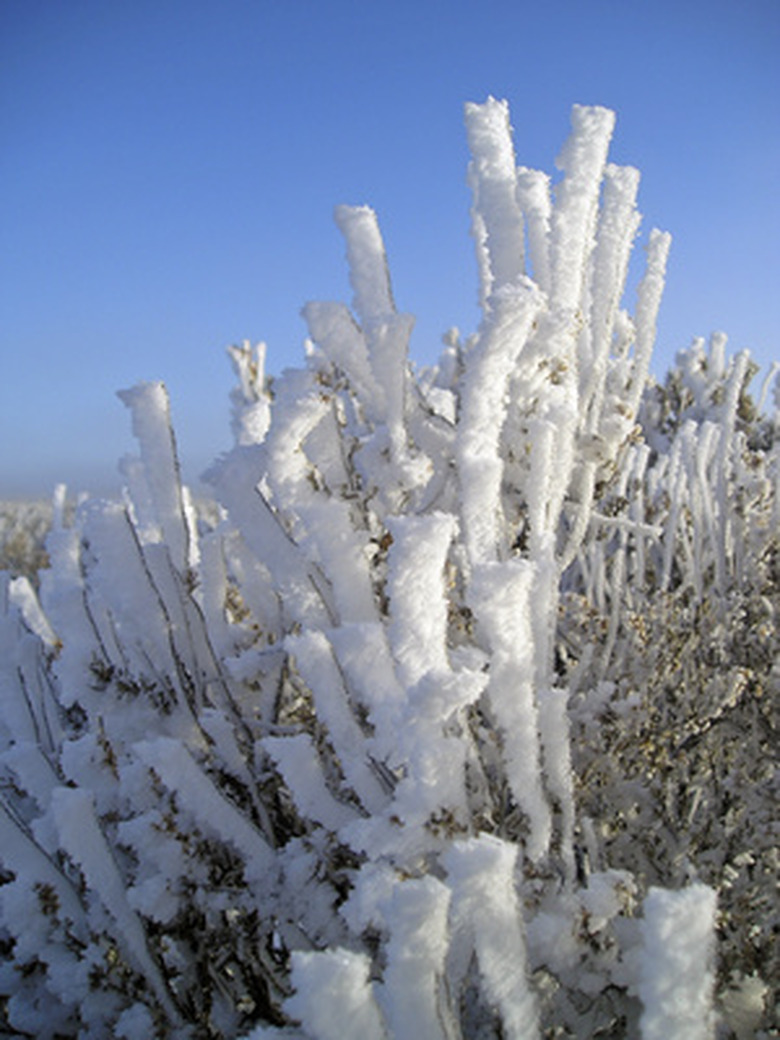Cold Desert Biome Plants
Biomes, says Weber State University, are large areas containing several similar ecosystems. The United States' Great Basin is a cold desert biome covering most of Utah and extending into Nevada and northern Arizona. Cooler temperatures and non-subtropical plants distinguish the cold desert biome from hot deserts. Cold desert biome plants have adapted to life in high elevations and can withstand colder winters than those in warm desert biomes.
Great Basin Sagebrush
Great Basin sagebrush (Artemisia tridentata), according to the Lady Bird Johnson Wildflower Center, is an evergreen shrub of the aster family. Standing anywhere from 18 inches to 9 feet high, with a somewhat smaller spread, it's a dominant cold desert biome plant and the Nevada state flower. Sagebrush grows wild on dry open flats and slopes. Its gnarled branches' small, silvery leaves give the plants a grayish-blue appearance. They emit an unmistakable, sharp but sweet scent.
- Biomes, says Weber State University, are large areas containing several similar ecosystems.
- Cooler temperatures and non-subtropical plants distinguish the cold desert biome from hot deserts.
Big sagebrush is a major winter and early spring food source for sage grouse, deer, elk and bighorn sheep. It provides nesting shelter for several songbird species. In late summer and fall, the plants have spikes of tiny yellow blooms along the tips of their branches. Plant the shrub in dry, rocky pH-neutral or acidic soil. It develops root rot in wet soils. Pruning the old branches promotes new growth.
Snakeweed
Another aster family perennial, snakeweed (Gutierrezia sarothrae) is a small, 1-to-3 foot densely branched shrub. Thread-fine yellow-green foliage sometimes drops from the lower half of the plants when they flower between August and November. Clusters of delicate yellow flowers grow from the branches' ends. Blooming plants are recognizable from their fan-like shape. The flowers attract bees and butterflies, and birds feed on snakeweed's seeds. Plant snakeweed, says the Lady Bird Johnson Wildflower Center, in a rock or perennial garden. It does best in poor, dry soil and part shade.
- Big sagebrush is a major winter and early spring food source for sage grouse, deer, elk and bighorn sheep.
- Blooming plants are recognizable from their fan-like shape.
Prickly Pear
Unlike most cacti, prickly pear (Opuntia macrorhiza Engelm.) is tolerant of the cold desert biome's high elevations (up to 7,000 feet) and snowy winters. A clumping blue-green plant standing just 10 inches high and up to 3 feet wide, it has flat pads. When mature, they produce showy, paper-like pale yellow, orange or red blooms in May and June. Edible purple-red fruit, used in preserves and candy, follows the flowers. Plant prickly pear, says the Lady Bird Johnson Wildflower Center, in rock gardens or along the tops of stone walls. It likes full sun and dry, rocky acidic soil.
- Unlike most cacti, prickly pear (Opuntia macrorhiza Engelm.)
- Edible purple-red fruit, used in preserves and candy, follows the flowers.
